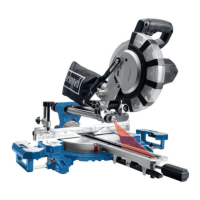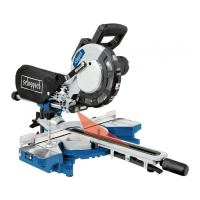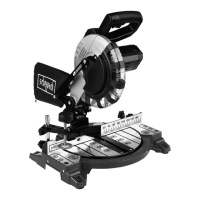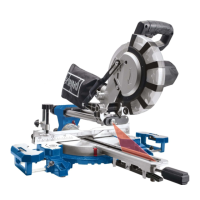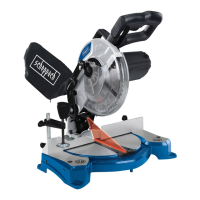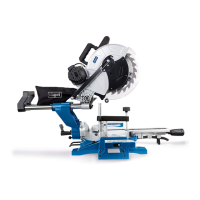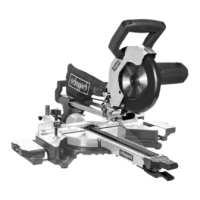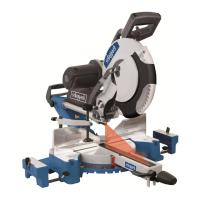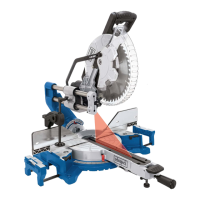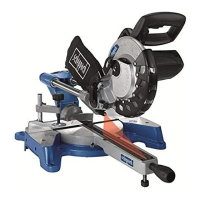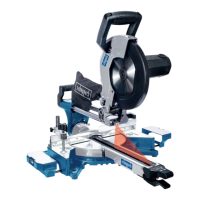www.scheppach.com
32
|
GB
Safety Instructions for the handling of saw blades
1. Do not use damaged or deformed saw blades.
2. Do not use any insertion tools with cracks. Sort out
cracked insertion tools. Repairs are not permitted.
3. Do not use saw blades made of high speed steel.
4. Check the condition of the saw blades before using
the crosscut, drag and mitre saw.
5. Make sure that a suitable saw blade for the mate-
rial to be cut is selected.
6. Only use saw blades recommended by the ma-
nufacturer.
Saw blades designed to cut wood and similar ma-
terials must comply with EN 847-1.
7. Do not use saw blades made of high-speed alloy
steel (HSS steel).
8. Only use saw blades for which the maximum per-
missible speed is not lower than the maximum
spindle speed of the crosscut, drag and mitre saw
and which are suitable for the material to be cut.
9. Observe the saw blade direction of rotation.
10. Only insertion the saw blade if you have mastered
their use.
11. Observe the maximum speed. The maximum
speed specied on the insertion tool may not be
exceeded. If specied, observe the speed range.
12. Clean grease, oil and water o of the clamping
surfaces.
13. Do not use any loose reducing rings or bushes for
the reducing of holes on saw blades.
14. Make sure that xed reducer rings for securing the
insertion tool have the same diameter and have at
least 1/3 of the cutting diameter.
15. Make sure that xed reducer rings are parallel to
each other.
16. Handle insertion tool with caution. They are ideally
stored in the originally package or special contai-
ners. Wear protective gloves in order to improve
grip and to further reduce the risk of injury.
17. Prior to the use of insertion tools, make sure that
all protective devices are properly fastened.
18. Prior to use, make sure that the insertion tool
meets the technical requirements of this electric
tool and is properly fastened.
19. Only use the supplied saw blade for cutting wood,
never for the processing of metals.
20. Only use saw blade diameters in accordance with
the markings on the saw.
21. Use additional workpiece supports, if required for
workpiece stability.
l) Provide adequate support such as table exten-
sions, saw horses, etc. for a workpiece that is
wider or longer than the table top. Workpieces
longer or wider than the mitre saw table can tip
if not securely supported. If the cut-o piece or
workpiece tips, it can lift the lower guard or be
thrown by the spinning blade.
m) Do not use another person as a substitute for
a table extension or as additional support. Un-
stable support for the workpiece can cause the
blade to bind or the workpiece to shift during the
cutting operation pulling you and the helper into
the spinning blade.
n) The cut-o piece must not be jammed or pres-
sed by any means against the spinning saw
blade. If conned, i.e. using length stops, the cut-
o piece could get wedged against the blade and
thrown violently.
o) Always use a clamp or a xture designed to
properly support round material such as rods
or tubing. Rods have a tendency to roll while
being cut, causing the blade to “bite” and pull the
work with your hand into the blade.
p) Let the blade reach full speed before contac-
ting the workpiece. This will reduce the risk of the
workpiece being thrown.
q) If the workpiece or blade becomes jammed,
turn the mitre saw o. Wait for all moving
parts to stop and disconnect the plug from
the power source and/or remove the battery
pack. Then work to free the jammed material.
Continued sawing with a jammed workpiece could
cause loss of control or damage to the mitre saw.
r) After nishing the cut, release the switch, hold
the saw head down and wait for the blade to
stop before removing the cut-o piece. Rea-
ching with your hand near the coasting blade is
dangerous.
s) Hold the handle rmly when making an incom-
plete cut or when releasing the switch before
the saw head is completely in the down posi-
tion. The braking action of the saw may cause the
saw head to be suddenly pulled downward, cau-
sing a risk of injury.
